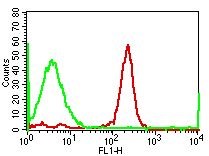Recombinant Human IL5 protein with C-terminal 6×His tag

Figure 1. Human IL5 Protein, His Tag on SDS-PAGE under reducing condition.
Roll over image to zoom in
Shipping Info:
For estimated delivery dates, please contact us at [email protected]
| Amount : | 50 µg |
| Purification : | The purity of the protein is greater than 95% as determined by SDS-PAGE and Coomassie blue staining. |
| Content : | Lyophilized from sterile PBS, pH 7.4. Normally 5 % - 8 % trehalose is added as protectants before lyophilization. |
| Storage condition : | Store at -80°C for 12 months (Avoid repeated freezing and thawing) |
| Alternative Name : | IL-5, TRF, Interleukin-5, EDF |
Expression Host : HEK293
The protein has a predicted molecular mass of 13.94 kDa after removal of the signal peptide.The apparent molecular mass of IL5-His is approximately 15-25 kDa due to glycosylation.
This gene encodes a cytokine that acts as a growth and differentiation factor for both B cells and eosinophils. The encoded cytokine plays a major role in the regulation of eosinophil formation, maturation, recruitment and survival. The increased production of this cytokine may be related to pathogenesis of eosinophil-dependent inflammatory diseases. This cytokine functions by binding to its receptor, which is a heterodimer, whose beta subunit is shared with the receptors for interleukine 3 (IL3) and colony stimulating factor 2 (CSF2/GM-CSF). This gene is located on chromosome 5 within a cytokine gene cluster which includes interleukin 4 (IL4), interleukin 13 (IL13), and CSF2 . This gene, IL4, and IL13 may be regulated coordinately by long-range regulatory elements spread over 120 kilobases on chromosome 5q31.
The protein has a predicted molecular mass of 13.94 kDa after removal of the signal peptide.The apparent molecular mass of IL5-His is approximately 15-25 kDa due to glycosylation.
This gene encodes a cytokine that acts as a growth and differentiation factor for both B cells and eosinophils. The encoded cytokine plays a major role in the regulation of eosinophil formation, maturation, recruitment and survival. The increased production of this cytokine may be related to pathogenesis of eosinophil-dependent inflammatory diseases. This cytokine functions by binding to its receptor, which is a heterodimer, whose beta subunit is shared with the receptors for interleukine 3 (IL3) and colony stimulating factor 2 (CSF2/GM-CSF). This gene is located on chromosome 5 within a cytokine gene cluster which includes interleukin 4 (IL4), interleukin 13 (IL13), and CSF2 . This gene, IL4, and IL13 may be regulated coordinately by long-range regulatory elements spread over 120 kilobases on chromosome 5q31.
|
There are currently no product reviews
|





















.png)










